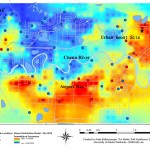Ravens roosting in Dumpster Central
February 17, 2011
907-474-7468
February 17, 2011
The ubiquitous Fairbanks raven is now even more so. Nighttime roosts — once documented as mysterious clumps of spruce trees where ravens slept far from people —can now mean a perch on the illuminated letters of the Barnes & Noble Booksellers sign.

Alaska’s country ravens have become citified, or so it seems. Dozens of the black birds are spending their evenings on the exterior structures of Fairbanks bookstores, pet shops, and in the garden centers of large box stores. They have been using these urban roosts for several years now, and seemed undisturbed by vehicles or people passing beneath them. This contrasts with a biologist’s study done 15 years ago.
The study found that a raven fitted with a backpack transmitter was flying 40 miles from the city to spend its evenings, and then flying 40 miles back at daybreak the next morning to gorge on the excesses of urbanites. Ravens have at times favored urban roosts in Fairbanks, but the current nightly congregation in the sprawling shopping complex on the north side of town is a large and persistent one.
“We created a large amount of winter habitat for ravens in that part of the city,” said Travis Booms, a biologist with the Alaska Department of Fish and Game in Fairbanks. “If they no longer have to fly long distances (in their commutes from roost to town, where the available food is), it saves them calories.
“It could be a population change,” Booms said. “Maybe the carrying capacity of their natural areas was exceeded and they’ve overflowed into the city. Or maybe it’s a learning thing. Maybe the population hasn’t changed, but they have adapted to city life.”

“It’s a great place, with a direct line to the landfill and McDonald’s,” agreed Susan Sharbaugh, senior scientist with the Alaska Bird Observatory. “If you can knock out a commute to the Goldstream Valley or Chena Hot Springs Road, why not? Energetically it makes all the sense in the world.” Despite seeing them around earlier on winter mornings at her workplace in Fairbanks, Sharbaugh suspects that the adaptable birds have not had a population explosion, but have figured out an easier way to live.
“Though I’ve got no data to back this up, I don’t think the raven population has increased that much or the numbers at dumpsters has increased,” she said. “I think they’re just roosting in a place we can see. It could be that the word has gotten out on the raven street that this is the place to be.” Just about anywhere people are in the business of selling food seems like a good place for ravens, according to early results from a study by University of Alaska graduate student Andy Baltensperger.
His advisor, Falk Huettmann, designed a study in which he and Baltensperger are modeling the occurrence of ravens around Fairbanks. They based the computer model on their winter trips to a random shotgun pattern of points on the Fairbanks map. They traveled to each location a few times during the past few winters and marked whether or not they saw a raven. They then introduced other variables to the model, such as distances to garbage transfer stations, distances to bodies of water, and city zoning patterns.
“Distance to restaurants and zone (with commercial seeming to be a raven preference) were the most important predictors,” Baltensperger said. Baltensperger created a probability map of the city with raven hot spots colored in orange and red. He said he wasn’t aware of the roosting site at the north Fairbanks shopping center and restaurant corridor, but he was happy to see his model had predicted, with a splash of orange, that a person has a high probability of encountering a raven there.
This column is provided as a public service by the Geophysical Institute, University of Alaska Fairbanks, in cooperation with the UAF research community. Ned Rozell is a science writer at the institute.


